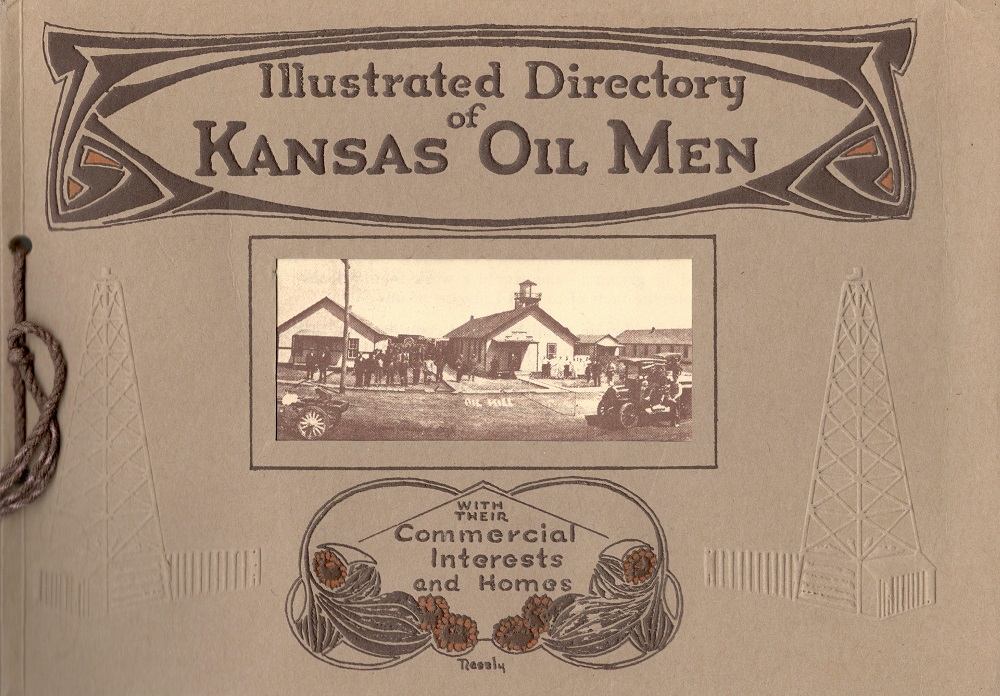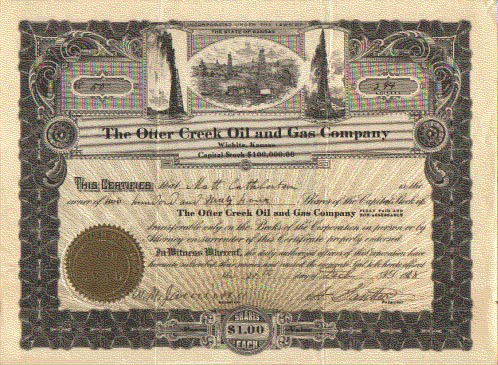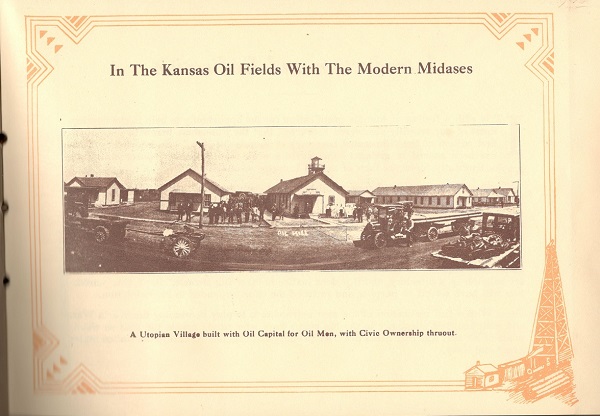
A 1918 directory praised Otter Creek Oil & Gas Company executive W.M. Jamieson.
A Mid-Continent oil discovery in 1915 revealed the giant El Dorado field and launched a Kansas oil boom. A subsidiary of Cities Service Company completed the Stapleton No. 1 well on October 5, 1915, in Butler County.
The discovery attracted many new and established companies to El Dorado and nearby Wichita, including Otter Creek Oil & Gas Company. According to the Kansas Oil Museum, the El Dorado oilfield, which proved to be 34-square-miles, was the first ever found using the science of petroleum geology.
“Before 1915, geologists were seen in the same vein as witching and doodlebugs. They were just charlatans,” explains Warren Martin in a 2015 Butler County Times-Gazette article on the centennial of the Stapleton No. 1 well. “It fundamentally transformed it from that point going forward. Geology was established as one of the great science industries.”
The earliest geological map of North America had been made in 1809. Geologic mapping in California began as early as 1826. Petroleum geology in the United States first gained status as a profession in 1917, when the American Association of Petroleum Geologists was organized.
Kansas oil discoveries (including an 1892 well at Neodesha), and gushers in North Texas, demonstrated existence of a petroleum-producing geologic region in the central and southwestern United States. Production from the Mid-Continent today includes hundreds of oilfields reaching from Kansas, Oklahoma and Texas into parts of Louisiana and Missouri.
Otter Creek Oil & Gas Company
Otter Creek Oil & Gas Company was formed in the summer of 1917 by three Wichita businessmen: A. Sautter, A.J. Engler and W.M. Jamieson. Sautter was associated with Piedmont Petroleum Company, which reportedly had drilled wells near Tussy, Oklahoma. Jamieson was among those featured in the Illustrated Directory of Kansas Oilmen in 1918:
 “In writing up Mr. W.M. Jamieson, secretary of Otter Creek Oil and Gas Company, it is unnecessary to resort to flower epigrams and dig up camouflage sensations,” noted the booklet featuring selected leaders of Butler County exploration companies and refineries, “with their commercial interests and homes.”
“In writing up Mr. W.M. Jamieson, secretary of Otter Creek Oil and Gas Company, it is unnecessary to resort to flower epigrams and dig up camouflage sensations,” noted the booklet featuring selected leaders of Butler County exploration companies and refineries, “with their commercial interests and homes.”
Otter Creek Oil & Gas Company had incorporated with a declared a capital par value of $1 per share and offered 100,000 shares. The company recorded 43 stock holders and holdings of 580 acres in Greenwood County, Kansas, Otter Creek township. Greenwood County borders Butler County to the east.
Although the company’s establishment corresponded with a surge in demand for petroleum that had begun at the start of World War I, production from a series of oilfield discoveries, including the “Roaring Ranger” in Texas, brought the industry’s familiar boom and bust cycle in prices.
Contemporary periodicals intermittently reported on Otter Creek Oil & Gas drilling operations in Greenwood County. Some reports included section-township-range descriptions, but records about the company’s exploratory wells have been elusive; reporting errors at the time also were frequent. There were other similarly named exploration companies in the region, too.
In November 1918, when the trade publication Oil & Gas News reported an Otter Creek Oil & Gas well to be shut down, company President Sautter demanded a correction. “I do not know where you got your information, but whoever gave it to you was wrong,” he declared, adding that “we have never been shut down,” and “for the information of our stockholders and the general public, I ask you to rectify this statement.”
 An Otter Creek township map shows properties owned by the McMillen family, who leased their mineral rights to Otter Creek Oil & Gas for oil exploration.
An Otter Creek township map shows properties owned by the McMillen family, who leased their mineral rights to Otter Creek Oil & Gas for oil exploration.
The November 20, 1919, Oil Distribution News reported the company’s well on that property to be shut down at 1,300 feet deep (Section 5, Township 28 South, Range 9 East), Greenwood County. The company’s outlook improved by April 1920, when another well attempt, again on the McMillen lease, drilled to a depth of 2,500 feet and reportedly set casing, indicating some oil production.
However, oilfield fortunes could change suddenly, leaving little explanation as to what happened. Intense competition throughout the Mid-Continent fields made good prospects hard to come by and expensive. Contracted drilling costs typically skyrocketed during booms. Many companies arrived too late, and some went bankrupt without drilling a single well. On August 10, 1921, when the Wichita Beacon newspaper published a list of 37 companies that had failed, Otter Creek Oil & Gas was among them.
Promoting the Kansas Oil Industry
Although it did not resort to “flower epigrams” in its praise of W.M. Jamieson, secretary of Otter Creek Oil and Gas Company, the Illustrated Directory of Kansas Oilmen came close. The booklet, published in 1918 by the Muncipal Publicity Company, was intended to “truthfully depict the facts of the Oil Industry in our State.”
In 96 pages, the directory featured leaders of Wichita and El Dorado-based oil companies, Butler County refinery owners, and “their commercial interests and homes.” It also explained the significance of the giant oilfield’s production, noting it provided Buttler County with $130 million in 1917.
Mr. W.M. Jamieson, featured on page 25, was reported to have first arrived in Kansas in 1883, but left to mine coal in New Mexico. In 1903 Jamieson “served as superintendent of excavation and tracks in building the great filtration plant for the city of Washington, D.C.”
He also worked for a railroad construction company in Cuba and “the swamps of the Amazon” and other parts of South America, where he reportedly drilled oil wells in 1908, according to the directory’s biography. His page notes that returning to Kansas by 1916, he found “some of the choice acreage” in Greenwood County.
The booklet’s final description of Jamieson was the praise and prediction that “he always attempts such big things and, somehow, has a knack of putting them thru – all contribute to the conviction that his association with The Otter Creek Oil and Gas Co. is enough to ensure its success.”
 ____________________________
____________________________
The stories of many exploration companies trying to join petroleum booms (and avoid busts) can be found in an updated series of research in Is my Old Oil Stock worth Anything?
AOGHS.org welcomes sponsors to help us preserve petroleum history. Please support this energy education website with a tax-deductible donation today. Contact bawells@aoghs.org for information on levels and types of available sponsorships. © 2017 AOGHS.

